Abstract
1. The pepsins and pepsinogens of the gastric mucosal extracts of two normal subjects, of seven patients with gastric adenocarcinoma and of two patients with duodenal ulcer have been investigated by agar-gel electrophoresis and by ion-exchange chromatography. 2. Of the eight zones of proteolytic activity that have previously been reported in normal human gastric juice, seven can be detected in activated fundic mucosal extracts. Of these seven, four can be attributed to discrete pepsins, numbered 1, 3a, 3 and 5. 3. Zone 7 results from the activity of one or more enzymes that are alkali-stable and are best referred to as gastric proteinases rather than as pepsins. Zone 7 is much more evident in mucosal extracts than in gastric juice. 4. Zones 4 and 6 may result respectively from the activity of a pepsin–inhibitor complex and of an unactivated zymogen. 5. It was not possible, by the chromatographic methods employed, to separate satisfactorily the individual pepsins from activated extracts or their precursors from unactivated extracts, so that the ascribing of a pepsin to a specific zymogen must be considered tentative. Even so, pepsin 3 appears to arise from at least two major precursors, if not from three, whereas pepsins 1 and 5 each arise from a single major precursor. 6. Pyloric mucosal extracts contain principally zone 5 but also zones 6 and 7. These zones in general behave similarly to the corresponding zones of fundic extracts, but pyloric pepsin 5 migrates slightly faster on agar-gel electrophoresis than does fundic pepsin 5 and is a different enzyme. Zones 1 to 4 are absent.
Full text
PDF
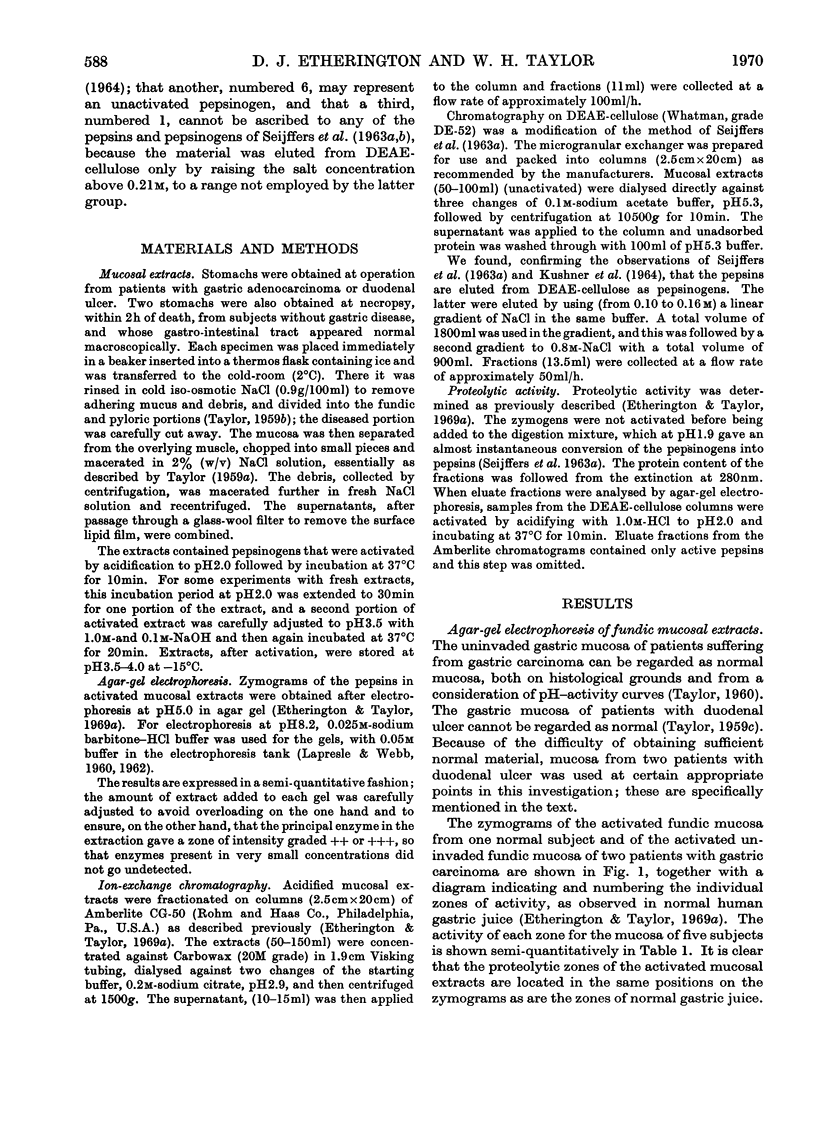
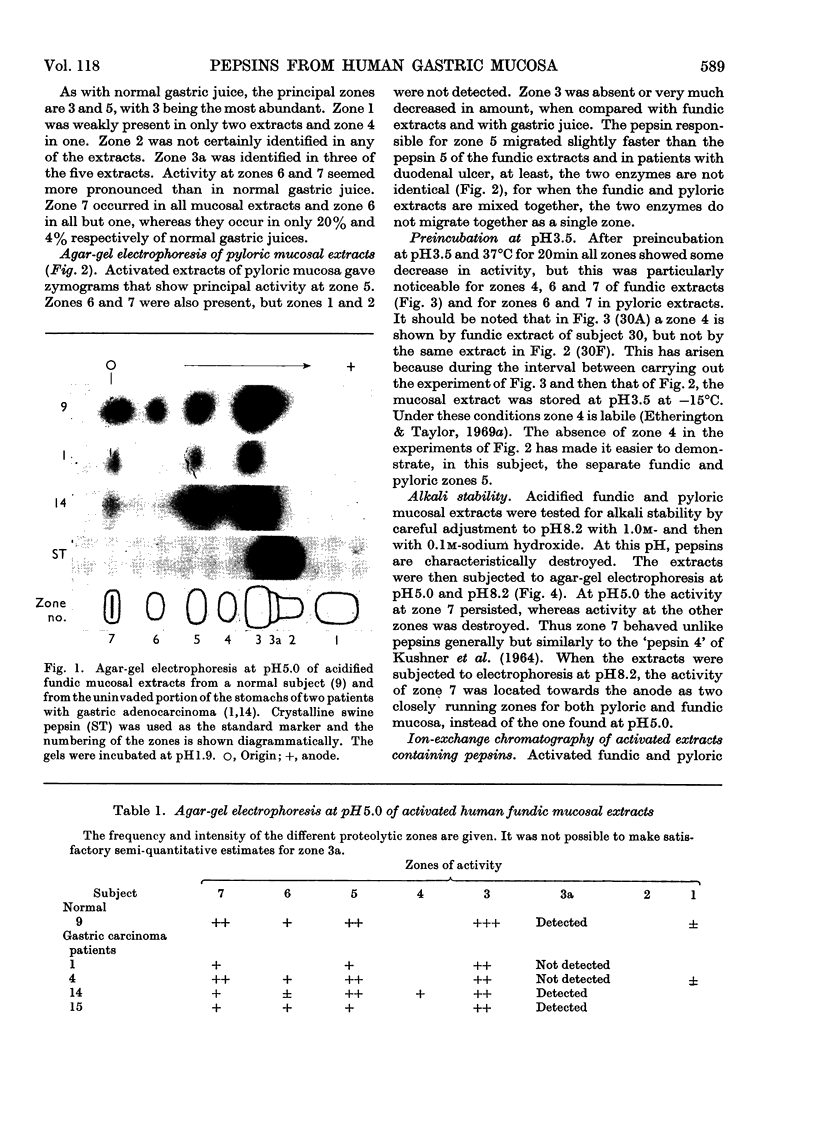
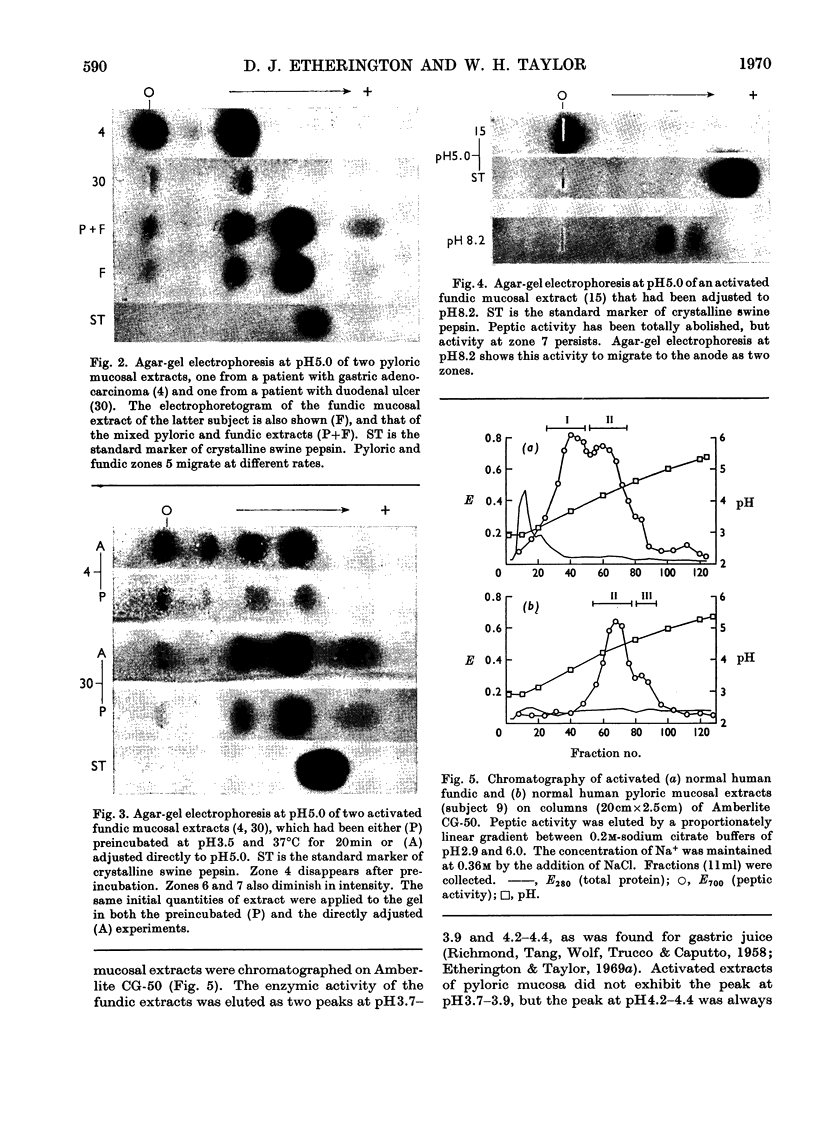
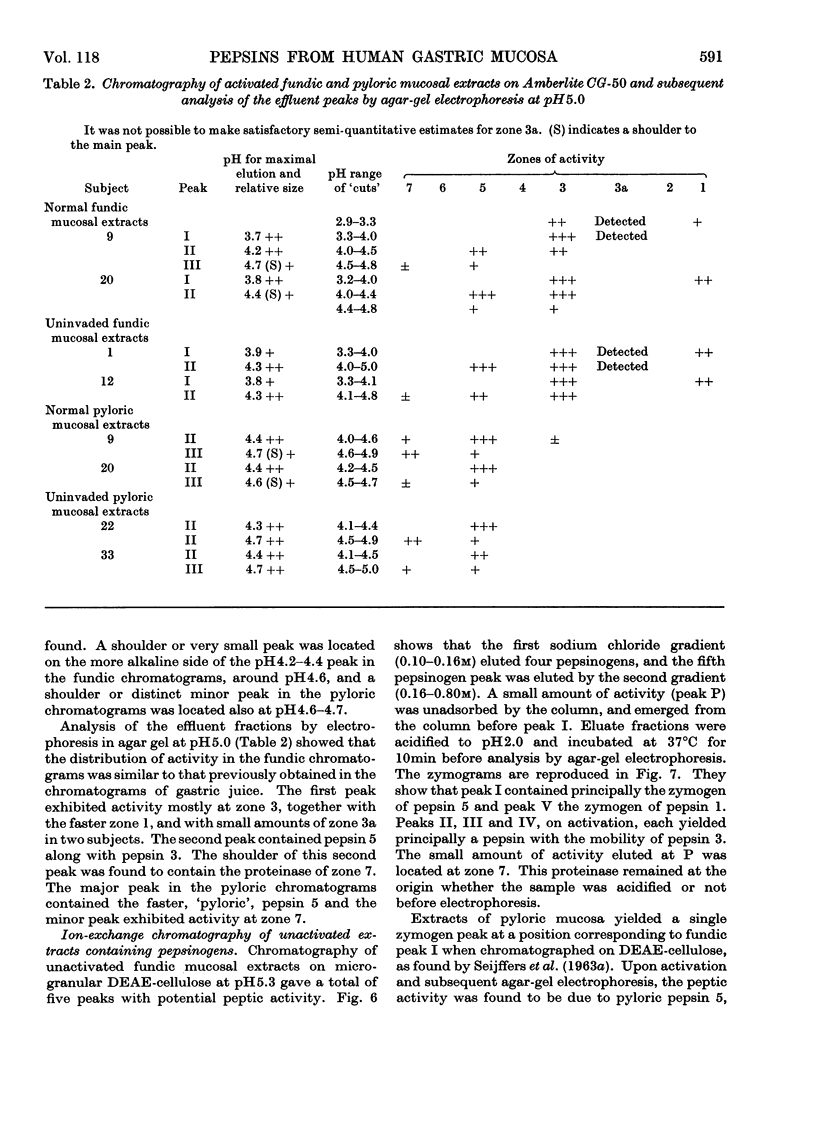
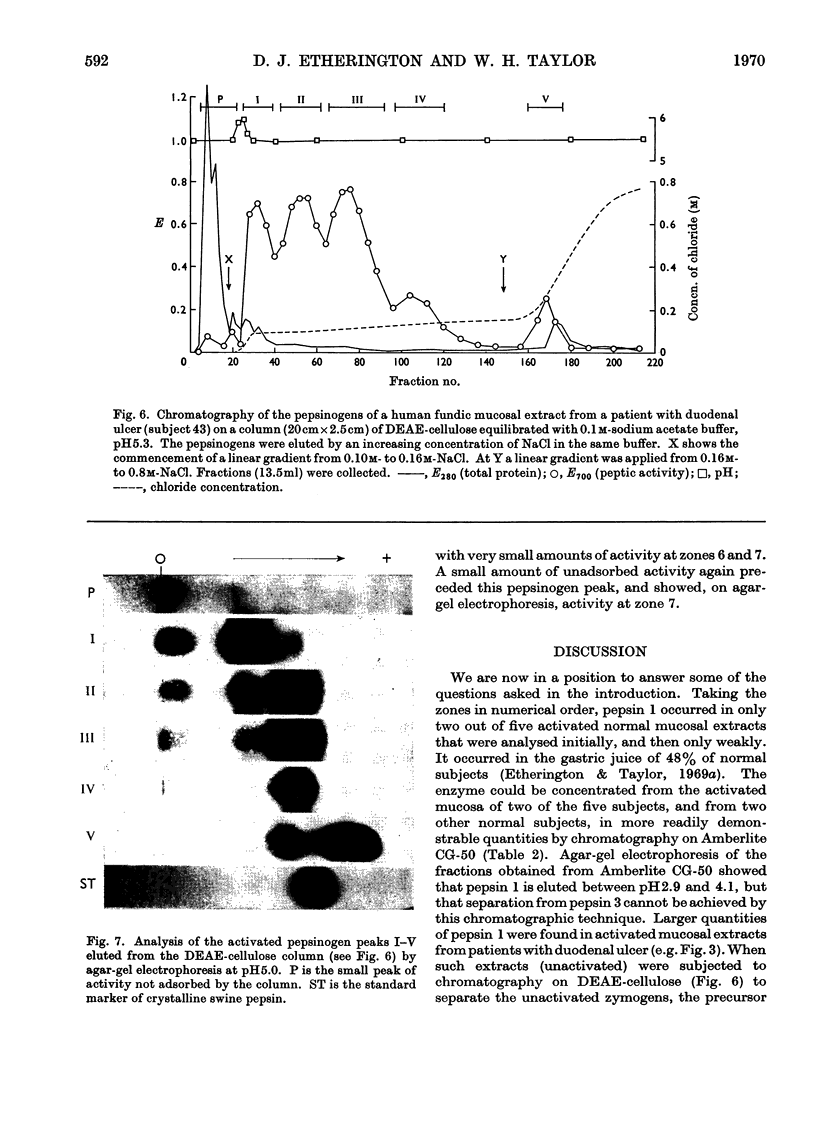
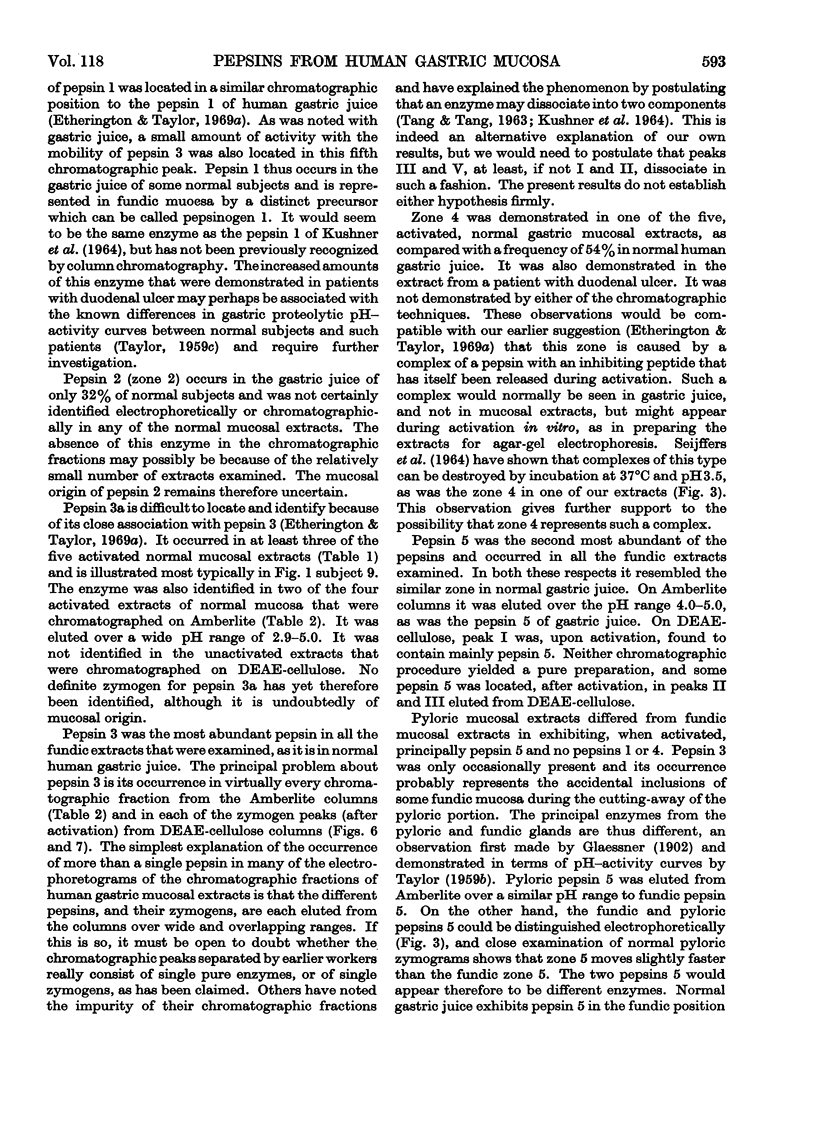
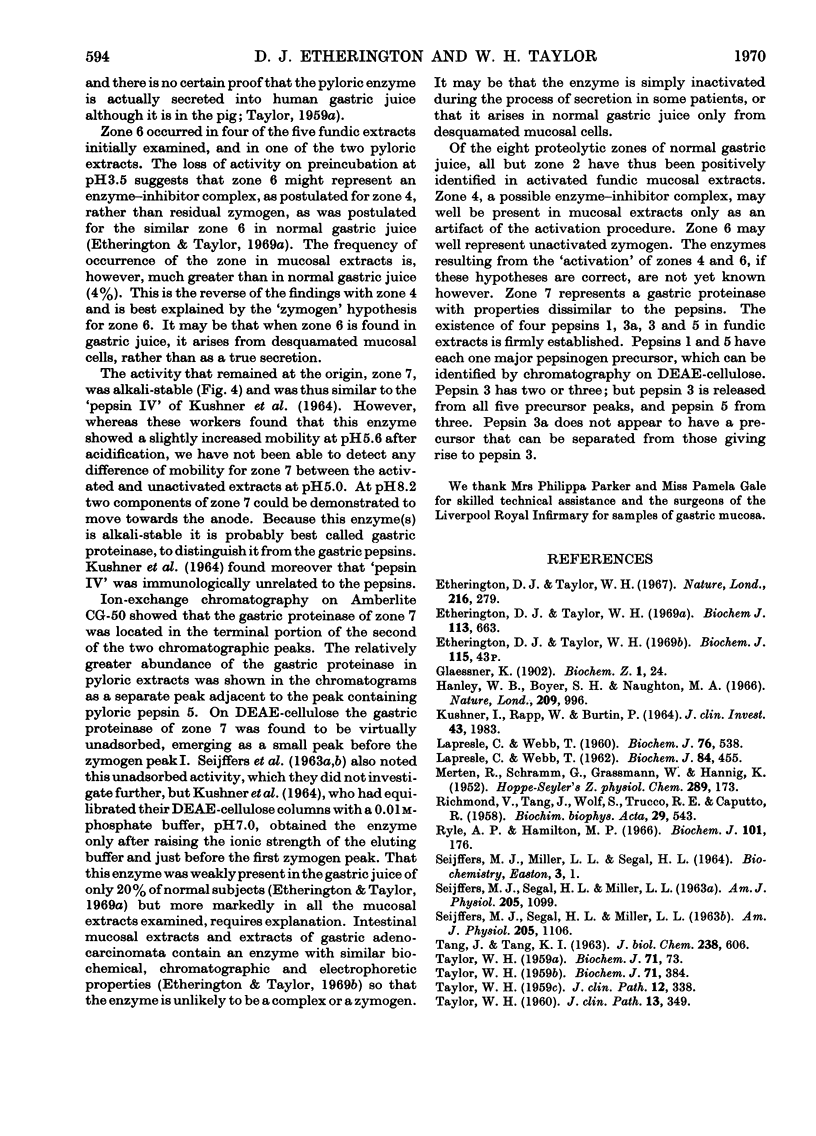
Images in this article
Selected References
These references are in PubMed. This may not be the complete list of references from this article.
- Etherington D. J., Taylor W. H. Investigation of the cathepsins of human gastric carcinomata. Biochem J. 1969 Dec;115(5):43P–44P. doi: 10.1042/bj1150043pa. [DOI] [PMC free article] [PubMed] [Google Scholar]
- Etherington D. J., Taylor W. H. Nomenclature of the pepsins. Nature. 1967 Oct 21;216(5112):279–280. doi: 10.1038/216279a0. [DOI] [PubMed] [Google Scholar]
- Etherington D. J., Taylor W. H. The pepsins of normal human gastric juice. Biochem J. 1969 Jul;113(4):663–668. doi: 10.1042/bj1130663. [DOI] [PMC free article] [PubMed] [Google Scholar]
- Hanley W. B., Boyer S. H., Naughton M. A. Electrophoretic and functional heterogeneity of pepsinogen in several species. Nature. 1966 Mar 5;209(5027):996–1002. doi: 10.1038/209996a0. [DOI] [PubMed] [Google Scholar]
- KUSHNER I., RAPP W., BURTIN P. ELECTROPHORETIC AND IMMUNOCHEMICAL DEMONSTRATION OF THE EXISTENCE OF FOUR HUMAN PEPSINOGENS. J Clin Invest. 1964 Oct;43:1983–1993. doi: 10.1172/JCI105072. [DOI] [PMC free article] [PubMed] [Google Scholar]
- LAPRESLE C., WEBB T. Study of a proteolytic enzyme from rabbit spleen. Biochem J. 1960 Sep;76:538–543. doi: 10.1042/bj0760538. [DOI] [PMC free article] [PubMed] [Google Scholar]
- LAPRESLE C., WEBB T. The purification and properties of a proteolytic enzyme, rabbit cathepsin E, and further studies on rabbit cathepsin D. Biochem J. 1962 Sep;84:455–462. doi: 10.1042/bj0840455. [DOI] [PMC free article] [PubMed] [Google Scholar]
- MERTEN R., SCHRAMM G., GRASSMANN W., HANNING K. Untersuchungen zur Reindarstellung des Magenkathepsins. Hoppe Seylers Z Physiol Chem. 1952;289(4):173–187. doi: 10.1515/bchm2.1952.289.4.173. [DOI] [PubMed] [Google Scholar]
- Ryle A. P., Hamilton M. P. Pepsinogen C and pepsin C. Further purification and amino acid composition. Biochem J. 1966 Oct;101(1):176–183. doi: 10.1042/bj1010176. [DOI] [PMC free article] [PubMed] [Google Scholar]
- SEIJFFERS M. J., SEGAL H. L., MILLER L. L. SEPARATION OF PEPSIN I, PEPSIN II A, PEPSIN II B, AND PEPSIN III FROM HUMAN GASTRIC MUCOSA. Am J Physiol. 1963 Dec;205:1099–1105. doi: 10.1152/ajplegacy.1963.205.6.1099. [DOI] [PubMed] [Google Scholar]
- SEIJFFERS M. J., SEGAL H. L., MILLER L. L. SEPARATION OF PEPSINOGEN I, PEPSINOGEN II, AND PEPSINOGEN III FROM HUMAN GASTRIC MUCOSA. Am J Physiol. 1963 Dec;205:1106–1112. doi: 10.1152/ajplegacy.1963.205.6.1106. [DOI] [PubMed] [Google Scholar]
- TANG J., TANG K. I. Purification and properties of a zymogen from human gastric mucosa. J Biol Chem. 1963 Feb;238:606–612. [PubMed] [Google Scholar]
- TAYLOR W. H. Gastric proteolysis in disease. 2. The proteolytic activity of gastric juice and gastric mucosal extracts from patients with chronic gastric and duodenal ulcer. J Clin Pathol. 1959 Jul;12:338–343. doi: 10.1136/jcp.12.4.338. [DOI] [PMC free article] [PubMed] [Google Scholar]
- TAYLOR W. H. Gastric proteolysis in disease. 4. Proteinase activity of extracts of human gastric adenocarcinomata. J Clin Pathol. 1960 Jul;13:349–352. doi: 10.1136/jcp.13.4.349. [DOI] [PMC free article] [PubMed] [Google Scholar]
- TAYLOR W. H. Studies on gastric proteolysis. 3. The secretion of different pepsins by fundic and pyloric glands of the stomach. Biochem J. 1959 Feb;71(2):384–388. doi: 10.1042/bj0710384. [DOI] [PMC free article] [PubMed] [Google Scholar]
- TAYLOR W. H. Studies on gastric proteolysis. I. The proteolytic activity of human gastric juice and pig and calf gastric mucosal extracts below pH5. Biochem J. 1959 Jan;71(1):73–83. doi: 10.1042/bj0710073. [DOI] [PMC free article] [PubMed] [Google Scholar]







